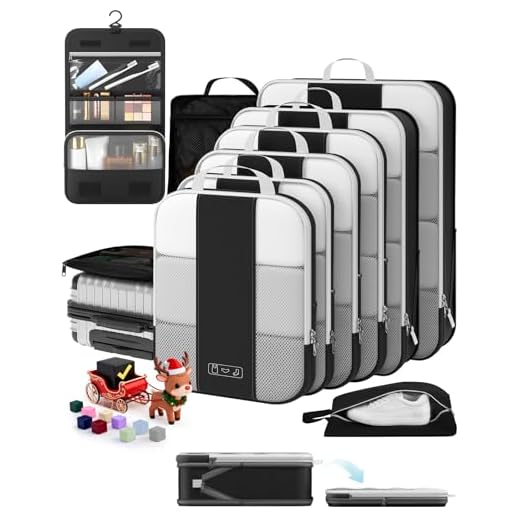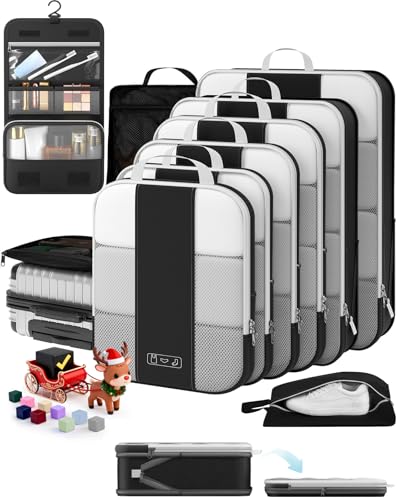







Weigh your suitcase before leaving home; digital scales can provide accurate measurements. This practice allows for adjustments early, avoiding surprises at the airport check-in.
Opt for lightweight items. Select travel gear made from lightweight materials to significantly decrease overall bag weight. For instance, embrace packable clothing and soft-shell luggage to maximize your comfort.
Utilize packing strategies such as the rolling method, which not only saves space but can also lower the overall weight. This technique minimizes air pockets, enabling a more compact arrangement.
Evaluate the contents critically. Separate essentials from non-essentials and eliminate duplicates. Many travelers find that they often pack items that can be bought at their destination, which may not be necessary.
Consider wearing multiple layers while traveling. This method allows you to leave room in your bag for more crucial items while staying warm during your journey.
Use compression bags for clothing. By reducing the volume of soft items, you can fit more into your case while maintaining compliance with weight limits.
Regularly check your airline’s baggage policy prior to traveling, as regulations may vary, including restrictions on weight or additional charges. Familiarity with these rules ensures smooth sailing at the airport.
Choosing the Right Luggage Size
Select a suitcase that matches the duration of your trip. For weekend getaways, consider a carry-on measuring 20-22 inches. For trips exceeding three days, opt for a medium size around 24-26 inches.
Utilize airline specifications for dimensions. Many carriers impose strict size limits, with a maximum width typically around 22 inches for cabin bags. Check the latest guidelines before packing.
Capacity Considerations
Assess the volume of your belongings. A 20-inch bag usually provides around 40 liters of space, while a 24-inch variant accommodates approximately 60 liters. Analyze your packing style and essentials to avoid over-packing.
Weight Matters
A lightweight suitcase is advantageous. Choose materials such as polycarbonate or nylon, which offer durability without unnecessary weight. Aim for a total weight below the airline’s allowance to prevent additional fees.
Plan for the return trip; factor in souvenirs or items acquired during travel. Selecting a slightly larger bag can provide the extra space needed without compromising on weight restrictions.
Understanding Airline Weight Limits
Check the specific weight restrictions set by the airline you’re flying with before packing. Most carriers have a maximum limit ranging from 50 to 70 pounds (23 to 32 kg) for checked bags and between 15 to 25 pounds (7 to 11 kg) for carry-ons. These thresholds can vary significantly, so always verify prior to your trip.
- Domestic vs. International Flights: Domestic flights might have different policies compared to international ones. Be aware of your carrier’s regulations for different routes.
- Class of Service: Business and first-class passengers often enjoy higher weight limits. Familiarize yourself with the allowances for your ticket type to maximize your packing strategy.
- Special Items: Items such as sports equipment, musical instruments, or oversized bags may have unique weight limitations or require additional fees. Check the airline’s guidelines to avoid surprises.
- Frequent Flyer Programs: Membership in loyalty programs may grant additional baggage allowances. Investigate if your status can provide extra weight limits.
Utilize your airline’s website or mobile app for real-time updates on weight allowances. This will prevent miscalculations and ensure your preparation aligns with current standards.
Consider creating an inventory of your items with weights listed. This method allows you to stay informed about your total weight while packing, minimizing the chance of exceeding limits.
Remember that fees for excess weight can be substantial, often ranging from $50 to $200 depending on the airline. Avoid these charges by tracking your packing effectively.
Lastly, always be prepared for possible changes in regulations or fees, especially during peak travel seasons. Have a flexible approach to managing your items before heading to the airport.
Packing Strategies to Maximize Space
Utilize packing cubes to optimize organization and maximize area in your suitcase. These containers allow items to be grouped by category, making it easy to find what you need while maintaining order. Consider rolling clothes instead of folding them; this method not only saves space but also minimizes wrinkles.
Strategic Item Selection
Limit footwear to two versatile pairs. Choose shoes that match multiple outfits and serve different functions, such as casual excursions and formal occasions. Clothing items should be selected based on versatility and ease of mixing and matching, ensuring each piece serves multiple purposes.
Utilize Every Inch
Fill all gaps and crevices within your travel case. Small items like socks or belts can be stuffed into shoes or gaps between larger pieces. Wear your bulkiest clothing during travel; this reduces volume inside the bag and keeps you warm on chilly flights.
Lastly, consider compressing soft items in vacuum storage bags. These bags can significantly reduce the volume of your clothes, allowing for more space without additional weight. Practice these techniques to make the most of limited space while keeping your essentials accessible.
Gadgets to Weigh Luggage Accurately
Using a portable digital scale provides precise measurements to ensure compliance with airline weight restrictions. Many models are compact and easy to use; simply hook the strap onto the handle of your bag and lift. Some recommended options come with features like backlit displays and maximum weight limits, typically around 50 kg (110 lbs).
Smartphone Apps
Several mobile applications can utilize your smartphone’s sensors to estimate weight. These tools can offer quick assessments when a scale isn’t available. While not as accurate as dedicated scales, they can serve as a complementary resource for travelers who frequently pack close to limits.
Integrated Weighing Systems
Consider investing in suitcases with built-in weighing features. These bags display the weight on an integrated LCD screen, ensuring you’re always aware of the contents’ total weight. Some brands also merge durability with modern technology, making them a valuable asset for frequent travelers.
For travelers utilizing umbrellas, check out the best choice products umbrella weight to avoid unexpected additions to your overall weight. Furthermore, if you need high-performance backpacks, the best tactical backpack made in usa combines lightweight design with practical storage solutions.
Tips for Minimizing Clothing Volume
Opt for compression packing cubes. These specially designed containers allow you to condense your garments by squeezing out excess air, maximizing available space within your carrier.
Choose Lightweight Fabrics
Select quick-drying and lightweight materials such as microfiber or moisture-wicking fabrics. They not only take up less room but also dry faster, allowing for easy washing on the go.
Rolling Technique
Roll garments instead of folding them. This method minimizes creasing and can save space, especially for items like T-shirts, pants, and lightweight outerwear.
| Clothing Types | Recommended Packing Method |
|---|---|
| T-Shirts | Roll |
| Pants | Roll |
| Dresses | Fold and Roll |
| Outerwear | Fold and Compress |
| Socks | Stuff in Shoes |
Reduce the number of shoes. Shoes can occupy considerable space, so bring versatile pairs that serve multiple purposes, like a pair suited for both casual outings and workouts.
Limit the number of outfits. Mix and match essentials to create various looks instead of packing an entire outfit for each day. Stick to a color palette that complements itself for versatility.
Ways to Reduce Non-Essential Items
Start with a thorough inventory of belongings. Write down everything you intend to pack, and then critically assess each item. Ask if it truly serves a purpose for your trip.
- Prioritize Multipurpose Items: Opt for clothing and gadgets that have multiple uses. For instance, a scarf can serve as a blanket, headwear, or fashion accessory.
- Limit Accessories: Restrict yourself to a few key accessories. Consider a versatile pair of shoes that match various outfits rather than packing several pairs.
- Digital Media: Instead of books, load digital versions on an e-reader or tablet. This saves space and weight while providing access to multiple titles.
- Evaluate Toiletries: Consolidate toiletries into smaller, travel-sized containers. Keep essential items only and consider solid alternatives to liquids.
- Leave Behind Non-Essentials: Avoid packing items that can be easily purchased at your destination, such as sunscreen or snacks.
Consider engaging in a challenge where you eliminate one item from your list for every day leading up to your trip. This process helps identify true necessities.
For those questioning whether certain items are harmful or unnecessary, a good source of information can be found here: are there gases in the foam insulation of freezers.
Finally, adopt a minimalist mindset. Embrace the idea that experiences outweigh material possessions during travel, encouraging thoughtful packing choices.








